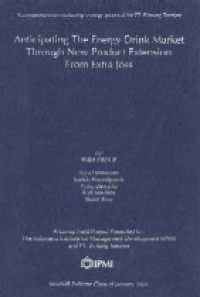
Improvement of Asset Turnover at Ice Cream Business Unit
| Gmd : Text
| Availability :
| 00000008649 | 138 | (GFP) | Available - Ada |
Ice Cream is a food product with a very international acceptance. Children, but increasingly all ages, have a natural liking of the product, which is indulgent and is strongly associated with fun and pleasant moments.
Because of the severe limitations and cost of refrigeration transport, ice cream until recently was a local, often non-industrial business. Technological progress has made cheap refrigeration and good infrastructure widely available over most parts of the developed market.
Combined with increasing spending power, this has created the opportunity for step change in the industry, leading to growing consumption and to the development of big players in the market.
A market, until recently served by thousands of small entrepreneurs is quickly becoming an area dominated by a few worldwide organizations. Unilever leads, followed by Nestle, Mars, Haagen Dazs and others.
Size in this business is important, economies of scale can create substantial savings in cost per unit sold, because a modern industrial ice cream operations is capital intensive. Considerable capital is required for the infrastructure to make the product available to the consumer at the right place at the right time, and to have sufficient stock when demand is there.
Additionally, the attainment of a leading position in the market provides strategic benefits which flow from such a position in shaping trade relations and in generating expectation amongst consumers that the leading company is more likely to be able to identify and satisfy their needs best.
The Ice Cream market in Indonesia continues to show extremely strong potential with an average growth of ca. 20% per annum in the coming five years (in the last five years this business has grown in average 26.5%). Current market size is estimated at 44 million liters which covers mainly urban areas. Consumption per capita is still very low (0.3 liter per capita) and this expected to accelerate as purchasing power increases and availability expands.1)
By end 1995 Wall's Ice Cream (PT.Unilever Indonesia's Ice Cream Business Unit) had grown six fold since its launch in 1992 and expected to grow in line with the market. The Wall's volume and value market share in 1996 is estimated 40% and 42% respectively, and being the leader in the market.
Financially, Unilever Indonesia's Ice Cream Business Unit grew quiet strong. In the third year after launch, profit before tax has showed a positive figure. The 1996 sales is estimated to reach Rp 100 billion and profit before tax Rp 5 billion. Gross profit is improving, from 4% in 1992 becoming 30% of sales in 1996. However, the return on investment2) of the unit has not been showing a good figures. The 1995 return on investment is 2.5%.
It has been noted by the top Unilever Indonesia management that the level of return on investment given by the Ice Cream unit has to be improved.
Research Location: PT. Unilever Indonesia
Supervisor: Prof. Dr. Wagiono Ismangil
Accepted on December 1996
For IPMI Internal -- Read at Library Only.
| Series Title |
-
|
|---|---|
| Call Number |
138
|
| Publisher Place | Jakarta |
| Collation |
iii, 52p.: tabs., figs.; 27 cm.
|
| Language |
English
|
| ISBN/ISSN |
-
|
| Classification |
-
|
| Media Type |
-
|
|---|---|
| Carrier Type |
-
|
| Edition |
-
|
| Subject(s) | |
| Specific Info |
-
|
| Statement |
-
|
| Content Type |
-
|
No other version available







